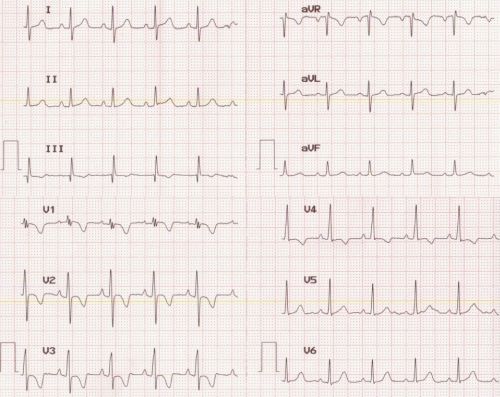Incomplete RBBB pattern in atrial septal defect
Incomplete RBBB pattern in atrial septal defect
Incomplete RBBB pattern in atrial septal defect
ECG showing incomplete right bundle branch block pattern seen in atrial septal defect. The mean QRS axis is rightward and there is an rsr’s’ pattern V1. The T wave inversions seen in leads V1 to V4 can be just a juvenile pattern or part of the IRBBB. The IRBBB pattern was thought to be due to hypertrophy of the crista supraventricularis. IRBBB pattern is seen in right ventricular volume overload. It could also be due to true delay in the right bundle branch. Even though IRBBB pattern is the characteristic ECG pattern of atrial septal defect, typical pattern may not be seen in all cases.
A “crochetage” sign has also been described in atrial septal defect. Crochetage sign [1] is a notch on the R waves in inferior leads, which has been reported to have a sensitivity of above 70% and specificity above 90% in some studies. Early disappearance of the crochetage sign was described in 35% after surgical correction of atrial septal defect, even when the IRBBB pattern was persisting.
Left axis deviation may be seen in ostium primum atrial septal defects. In sinus venosus type of atrial septal defect, sinus node may be defective and abnormal focus in the form of low atrial or coronary sinus rhythm may be observed. Low atrial rhythm is characterised by inverted P waves in inferior leads. Prolonged PR interval or first degree AV block may be seen in familial secundum atrial septal defects. These cases are transmitted in an autosomal dominant pattern.
Reference
- Heller J et al. “Crochetage” (notch) on R wave in inferior limb leads: a new independent electrocardiographic sign of atrial septal defect. J Am Coll Cardiol. 1996 Mar 15;27(4):877-82.

